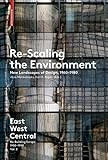East West Central : Re-building Europe, 1950-1990. Volume 2, Re-Scaling the Environment ; New Landscapes of Design, 1960-1980 / ed. by Ákos Moravánszky, Karl R. Kegler.
Material type: TextSeries: East West Central ; Volume 2Publisher: Basel : Birkhäuser, [2016]Copyright date: ©2017Description: 1 online resource (320 p.)Content type:
TextSeries: East West Central ; Volume 2Publisher: Basel : Birkhäuser, [2016]Copyright date: ©2017Description: 1 online resource (320 p.)Content type: - 9783035610161
- 9783035608236
- Architecture and society -- Europe
- Architecture -- History -- 20th century -- Europe
- Architecture -- Technological innovations -- Europe -- Europe -- History
- Architecture -- Technological innovations -- Europe
- Architecture -- Europe -- History -- 20th century
- Architectural History
- Architekturgeschichte
- Europa
- Europe
- Nachkriegsmoderne
- Postwar Architecture
- ARCHITECTURE / History / Contemporary (1945-)
- 724.6 23
- NA958 .R473 2017
- online - DeGruyter
| Item type | Current library | Call number | URL | Status | Notes | Barcode | |
|---|---|---|---|---|---|---|---|
 eBook
eBook
|
Biblioteca "Angelicum" Pont. Univ. S.Tommaso d'Aquino Nuvola online | online - DeGruyter (Browse shelf(Opens below)) | Online access | Not for loan (Accesso limitato) | Accesso per gli utenti autorizzati / Access for authorized users | (dgr)9783035608236 |
Frontmatter -- Contents -- Foreword. East West Central: Re-Building Europe -- Introduction. On Systems and System Change -- I. Technology: New Scales and Projects -- Zooming In: The Powers of Scale, 1960–1980 -- The Choreography of the Console: Electronic Environments and their Operators -- Rittel’s Riddles: Design Education and “Democratic” Planning in the Age of Information -- Nested Utopias: GEAM’s Large-Scale Designs -- On Bees and Bolts: Školka SIAL – An Architects’ Commune in Czechoslovakia -- II. Planning, Design and Territory -- Le Corbusier’s “Geo-Architecture” and the Emergence of Territorial Aesthetics -- Projective Geographies Between East and West -- Towards the Functional Society: Paradigm Shifts in the Regional Planning of West and East Germany -- Vacationing within the Walls. The Design and Development of Holiday Resorts in the GDR -- Urbanism and Academia: Teaching Urban Design in the East -- III. Practices and Agencies -- Architectural Intelligence and Scarcity-Driven Design in the 1960s Yugoslavia -- From New Empiricism to Structuralism. The Swedish National Board of Public Building (KBS) -- Courtyards, Corners, Streetfronts: Re-Imagining Mass Housing Areas in Tallinn -- “Complex Projects”: Landscape Architecture as the Integrating Discipline -- UIA, R. Buckminster Fuller, and the Architectural Consequences of “Total Environment” -- New Agencies: Convergent Frameworks of Research and Architectural Design -- Appendix -- Notes on Contributors -- Index
restricted access online access with authorization star
http://purl.org/coar/access_right/c_16ec
From 1960–1980, both eastern and western Europe experienced a construction boom of new dimensions. Cybernetics, the science of planning, and sociology, as well as the new possibilities offered by technology and production, paved the way to large-scale processes and systems in architecture and urban design, which favored technocratic and utopian concepts. Increasingly, architects and planners saw themselves as designers of comprehensive infrastructure and mega-structures in a technology-focused world. The authors assesses these developments on the back of a knowledge transfer between East and West. It confirms a change in attitude that can still be felt today – recession, social changes, and environmental problems led to criticism of the then contemporary concepts of modernity.
Von 1960 bis 1980 erlebten Ost-und Westeuropa eine Bauproduktion von bis dahin unbekanntem Ausmaß. Kybernetik, Planungswissenschaft und Soziologie sowie neue Möglichkeiten von Technologie und Produktion eröffneten in Architektur und Raumplanung ein Denken in Prozessen, Systemen und großen Maßstäben, das technokratische und utopische Konzepte begünstigte. Architekten und Planer verstanden sich zunehmend als Gestalter umfassender Infra- und Megastrukturen einer technisierten Lebenswelt. Das internationale Autorenteam behandelt diese Entwicklungen vor dem Hintergrund des Wissenstransfers zwischen Ost und West. Es konstatiert einen bis heute nachwirkenden Umschwung: Rezession, gesellschaftliche Umbrüche und Umweltprobleme führten zur Kritik an bisherigen Konzeptionen von Modernität.
Mode of access: Internet via World Wide Web.
In English.
Description based on online resource; title from PDF title page (publisher's Web site, viewed 30. Aug 2021)


